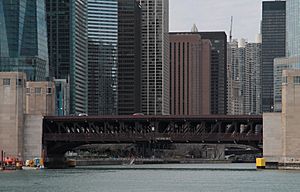Outer Drive Bridge facts for kids
Quick facts for kids Outer Drive Bridge |
|
|---|---|

The double-decker Outer Drive Bridge across the Chicago River
|
|
| Coordinates | 41°53′18.3″N 87°36′50.6″W / 41.888417°N 87.614056°W |
| Carries | Motor vehicles, cyclists, pedestrians on Chicago Lakefront Trail and Lake Shore Drive |
| Crosses | Chicago River |
| Locale | Chicago |
| Official name | Franklin Delano Roosevelt Memorial Bridge |
| Named for | Centennial anniversary of Franklin D. Roosevelt's birth |
| Owner | City of Chicago |
| Maintained by | Chicago Department of Transportation |
| ID number | 16603027328 |
| Preceded by | Chicago Harbor Lock |
| Followed by | Columbus Drive (William P. Fahey) Bridge |
| Characteristics | |
| Design | Double-leaf, double-deck, fixed counterweight, trunnion bascule bridge |
| Material | steel |
| Total length | 356 feet (109 m) |
| Width | 80.7 feet (24.6 m) |
| Longest span | 264 feet (80 m) |
| Number of spans | 1 main span and 3 approach spans |
| History | |
| Designer | Joseph Strauss |
| Engineering design by | City of Chicago |
| Constructed by | Ketler-Elliott Company |
| Construction begin | 1929 |
| Construction end | 1937 |
| Inaugurated | 5 October 1937 |
| Rebuilt | 1987 |
The Outer Drive Bridge, also called the Link Bridge, is a special kind of bridge in Chicago, Illinois. It has two levels and can open up to let boats pass. This bridge carries Lake Shore Drive over the Chicago River.
Building the bridge started in 1929 and finished in 1937. It was part of a big government program called the Public Works Administration. This program created jobs and built important things during a tough economic time. In 1982, the bridge was officially named the Franklin Delano Roosevelt Memorial Bridge. This honored the 100th birthday of Franklin D. Roosevelt, who was a United States President.
The Chicago Plan Commission helped plan the bridge. It was designed by the Strauss Engineering Company. The Ketler and Elliot Company built it. The bridge is located near where the Chicago River meets Lake Michigan.
Contents
Why Was This Bridge Built?
The Outer Drive Bridge was built for two main reasons. First, it created many jobs for people in Chicago. This was very important during the Great Depression. Second, it helped make traffic flow better. Before this bridge, traffic on Michigan Avenue and in the downtown area, known as the Loop, was often very bad.
When it was finished in 1937, this bridge was amazing. It was the longest, widest, and heaviest bascule bridge in the world. A bascule bridge is a type of drawbridge that opens by lifting a section.
The road that crosses the bridge is called Lake Shore Drive. It connects the south side of Chicago to the north side. This important road runs along the western shore of Lake Michigan. It starts in Jackson Park on the South Side. Then it goes through the Loop, crosses this bridge over the Chicago River, and ends near Hollywood Avenue on the city's North Side.
How Was the Bridge Funded?
Building the Outer Drive was a very important project for the Public Works Administration. However, it took many years to complete. A big problem was getting enough money.
At one point, the money set aside for the bridge was taken away. This happened because the local park districts could not meet certain financial rules. The money was only given back once the park districts were ready to follow the rules. The total cost to build the Outer Drive, including the bridge, was about $11,563,000.
How Does the Bridge Work?
The Outer Drive Bridge is a complex machine. Each side of the bridge, called a "leaf," has its own powerful system to make it move. This system uses gears and motors.
Each leaf has two sets of gears. These gears are connected to two strong 100-horsepower motors. Usually, only one motor is needed to operate each leaf at a time. The bridge can open or close in less than a minute, even in strong winds. It takes about 57.6 seconds to fully open or close.
There are also special locks that hold the bridge together when it is closed. One set of locks is in the middle of the bridge. These locks connect the two leaves and help share the weight of traffic. Another set of locks, called "heel locks," are at the back of each leaf. These stop the leaves from accidentally opening when cars drive over them. Each leaf has four heel locks, powered by two 15-horsepower motors.
Images for kids
-
Bridge raised for sailboats, viewed looking east, toward Navy Pier





